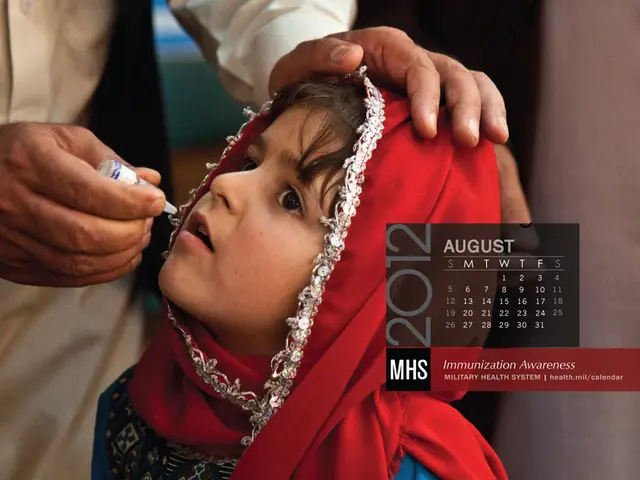Differentiating Age Spots from Skin Cancer: Key Signs to Look Out For
Revised Article:
Hey there! Let's chat about age spots and skin cancer – two conditions that can leave you scratching your head (or your skin, in this case). Both can appear similar on the surface, but they've got some key differences that will help you spot the warning signs.
Age Spots vs. Skin Cancer:
Age spots and skin cancer share the sunny spots on your body, but that's pretty much where their similarities end. Unlike skin cancer, age spots are harmless and don't warrant any treatment.
Age Spots:
These bad boys, also known as solar lentigines or liver spots, are just patches of pigment that show up as darker spots against your skin. They're usually flat, smooth, and don't itch or feel rough like scabs.
Age spots emerge as your body goes into overdrive to produce excess melanin to protect your skin from the sun's harsh UV rays. This tanning effect is more prevalent in fair skin, but they can pop up on any complexion. Most folks notice them sailing into their middle age.
Skin Cancer:
Ah, now this is the real deal. Skin cancer is just that – cancer that starts in your skin. It's most common in areas hit hard by the sun's rays, like your face, hands, shoulders, and more. This isn't because it enjoys a good tan; it's actually due to the damage caused by UV radiation from the sun or tanning beds.
When UV radiation or various environmental or genetic factors wreak havoc on your skin cells, they start to mutate, multiply, and spread at an accelerated pace. This is where things get serious. Skin cancer isn't just a simple cosmetic concern – it can pose a real threat if left untreated.
The three most common types of skin cancer are basal cell carcinoma, squamous cell carcinoma, and melanoma. But there's another mark that can blend in with age spots – actinic keratosis, a precancerous growth caused by excessive sun exposure.
When Actinic Keratosis Might Transform:
While age spots won't turn into cancer, actinic keratosis is another story altogether. Actinic keratosis is a precancerous growth that can evolve into skin cancer if left unchecked. So, keep an eye on these babies and chat with your healthcare provider if any symptoms arise.
Symptom Comparison:
There are some noteworthy differences in the symptoms between age spots and skin cancer that will help you spot what's brewing.
Age Spots Symptoms:
- Flat and smooth
- Yellow, brown, or gray
- Clearly defined borders
- Varying sizes, anywhere from millimeters to centimeters
- Commonly appear on sun-exposed areas (like your face, hands, shoulders, feet, arms, and back)
- Fade in winter and darken in summer
Skin Cancer Symptoms:
Skin cancer symptoms can vary, but here are some signs that something might be amiss:
- Symmetrical, irregular, or jagged shapes
- Changing size, color, or shape
- Multiple colors on the same spot
- Pink, blue, purple, black, or brown coloring
- Raised, red patches
- Pale or yellow firm patches that resemble scars
- Pain, itching, oozing, or bleeding
- Crusty or scaly patches
- Raised edges that lower in the middle
Signs of actinic keratosis include:
- Rough, scaly patches
- Red, pink, or pale patches
- Flat, scaly patches resembling age spots
- Clusters of scaly bumps similar to acne
- Horn-like growths
When to Contact a Doctor:
If you notice any skin irregularities that aren't typical for you, it's crucial to connect with a healthcare professional. Early detection can make treating skin cancer easier and help you maintain optimal health. Contact a medical expert if:
- A skin mark changes in color, shape, location, or size
- The mark differs from other marks on your skin
- The spot itches, scabs over, or takes over 4 weeks to heal
Diagnosis:
To figure out if you're dealing with age spots or something more serious, a healthcare professional will perform a thorough examination of the spot. If they're unsure, they might conduct a skin biopsy to rule out other conditions, like skin cancer or actinic keratosis.
Treatment:
Age spots don't require treatment because they're harmless, but some folks might choose to have treatment to minimize their appearance. Potential treatments include creams, lotions, or procedures like laser therapy, cryosurgery, microdermabrasion, or chemical peels.
Skin cancer treatments vary depending on the type and stage of cancer, as well as your individual circumstances. Options include surgery, topical treatments, radiation therapy, chemotherapy, immunotherapy, or systemic medication.
The Bottom Line:
Spotting the differences between age spots and skin cancer (or even actinic keratosis) can help you stay ahead of potential health issues. Keep an eye on your skin, and if you notice anything unusual, chat with a doctor ASAP. Early detection is key! Stay fit, my friend! 🌞💪🚀
- In the field of oncology, melanoma is a type of skin cancer that requires immediate attention due to its potential threat to health.
- As a senior, it's important to be aware of medical-conditions such as skin cancer, including melanoma, and to seek medical advice if any unusual symptoms occur.
- Dermatology plays a crucial role in the early detection and treatment of various skin-care issues, including skin cancer, age spots, and other skin-conditions like actinic keratosis.
- Scientists continue to study the causes and effects of various health-and-wellness issues, including skin cancer, to develop more effective prevention and treatment methods.
- Regular self-examinations and skin-care routines, such as using sunscreen and avoiding excessive sun exposure, can help prevent other skin-conditions like age spots, actinic keratosis, and the progression of skin cancer.








